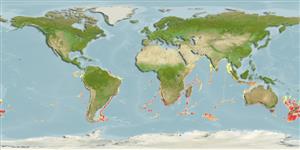Environment: milieu / climate zone / depth range / distribution range
Ökologie
seewasser bathydemersal; tiefenbereich 360 - 1300 m (Ref. 44037). Deep-water
Southeast Atlantic: Walvis Bay to Durban, South Africa. Southwest Atlantic: Brazil. Southeast Pacific: Chile. Eastern Indian Ocean: southern Australia, from Western Australia to New South Wales and Tasmania. Southwest Pacific: New Zealand.
Size / Gewicht / Alter
Maturity: Lm ? range ? - ? cm
Max length : 60.0 cm TL Männchen/unbestimmt; (Ref. 6594)
Rückenflossenstacheln (insgesamt): 5 - 9; Rückenflossenweichstrahlen (insgesamt): 0-1; Afterflossenstacheln 10-18; Afterflossenweichstrahlen: 115 - 160. Pelvic fins with 1-3 spines, the first of which is rudimentary (Ref. 27363). Body dark brown, with darker fins (Ref. 27363) and mouth (Ref. 6594).
Occurs on the continental slope (Ref. 9563). Feeds on benthic copepods and polychaetes (Ref. 27637).
Life cycle and mating behavior
Geschlechtsreife | Fortpflanzung | Ablaichen | Eier | Fecundity | Larven
Sulak, K.J., 1986. Notacanthidae. p. 195-196. In M.M. Smith and P.C. Heemstra (eds.) Smiths' sea fishes. Springer-Verlag, Berlin. (Ref. 6594)
IUCN Rote Liste Status (Ref. 130435)
Bedrohung für Menschen
Harmless
Nutzung durch Menschen
Mehr Information
NamenSynonymeMetabolismusRäuberÖkotoxikologieFortpflanzungGeschlechtsreifeAblaichenSpawning aggregationFecundityEierEientwicklung
ReferenzenAquakulturAquakultur ProfilZuchtlinienGenetikElectrophoresesVererbbarkeitKrankheitenVerarbeitungNutrientsMass conversion
PartnerBilderStamps, Coins Misc.LauteCiguateraGeschwindigkeitSchwimmstilKiemenoberflächeOtolithsGehirngrößeSehfähigkeit
Tools
Zusatzinformationen
Download XML
Internet Quellen
Estimates based on models
Preferred temperature (Ref.
123201): 2.3 - 10, mean 7.1 °C (based on 467 cells).
Phylogenetic diversity index (Ref.
82804): PD
50 = 0.5161 [Uniqueness, from 0.5 = low to 2.0 = high].
Bayesian length-weight: a=0.00102 (0.00046 - 0.00225), b=3.06 (2.88 - 3.24), in cm total length, based on all LWR estimates for this body shape (Ref.
93245).
Trophic level (Ref.
69278): 3.0 ±0.17 se; based on food items.
Widerstandsfähigkeit (Ref.
120179): sehr niedrig, Verdopplung der Population dauert mehr als 14 Jahre. (Preliminary K or Fecundity.).
Fishing Vulnerability (Ref.
59153): Moderate vulnerability (44 of 100).
